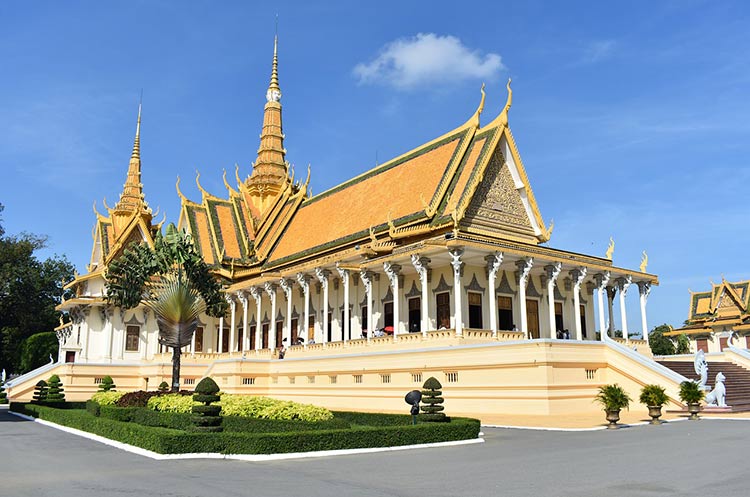
Royal Palace & Silver Pagoda
Ornate Khmer style architecture
The ornate Khmer style buildings, manicured gardens, golden glow in the sunlight and riverside location make the Royal Palace one of the most attractive sites in Phnom Penh.
The Throne Hall, Silver Pagoda and Napoleon Pavilion are open to visitors.
Built in 1866
King Norodom ordered the Royal Palace built when Phnom Penh became the capital of Cambodia. Construction started in 1866. Since completion in 1870, the palace has served as the residence of Cambodian Kings. The palace was rebuilt in the 1910’s, the only building remaining from the original being the Napoleon Pavilion.
Four gates
The Royal Palace has four gates.
The Eastern Victory Gate is for VIP and Royalty. The North funeral gate only opens after the death of a royal. Prisoners that were to be executed were led out of the palace grounds through the West gate. Finally, the South gate is where visitors enter the palace grounds.

Photo by Marcin Konsek (CC BY-SA 4.0)
Two courtyards
The Royal Palace consists of a Western and an Eastern courtyard.
Western courtyard
The Western courtyard contains the King’s private living quarters (Khemarin Palace) and the Villa Kantha Bopha for the King’s guests. When the blue flag is flying, the King is in the palace. The Western courtyard is closed to visitors.
Eastern courtyard
The Eastern courtyard is open to visitors. This area houses the Throne Hall, Napoleon Pavilion, Phochani Pavilion, Damnak Chan and the Moonlight Pavilion.
Throne Hall
The Throne Hall or Preah Tineang was built in 1917. The hall is used for coronations and Buddhist ceremonies.
Standing on a base and surrounded by white pillars, the Throne Hall is guarded by a couple of white lions. Multi headed Naga serpents line the balustrades of the stairway.
The Throne Hall is topped with three golden spires. On top of the central spire is the four faced head of Brahma, the Hindu God of Creation.
It is not allowed to take photos inside the Throne Hall.
The thrones
Inside the hall are three thrones. The Preah Tineang Bossabok is an old intricate throne adorned with detailed carvings. It is the throne the new King sits on wearing the Royal Regalia during coronation. Another throne, the Preah Tineang Nearyrath Bossabok, is used by the Queen.
Colorful frescoes
The ceiling is adorned with colorful frescoes of the Reamker, the Cambodian version of the Ramayana epic.

On the central spire of the Throne Hall
The Bronze House
The small building next to the Throne Hall is called the Bronze House. It exhibits clothing and artifacts used in ceremonies such as the coronation of King Norodom Sihamoni in 2004.
Moonlight pavilion
The Moonlight Pavilion or Preah Thineang Chan Chhaya is an open pavilion in Khmer style topped with a golden central spire.
Completed in 1914, the pavilion is used for Khmer classical dance performances and Royal banquets. The King stands in the Moonlight Pavilion when addressing the Cambodian people.
Silver Pagoda
Directly South of the Royal Palace is the Silver Pagoda compound.
Emerald Buddha temple
The main building in the Silver Pagoda compound is the Emerald Buddha temple, in Cambodian known as Preah Vihear Preah Keo Morakot.
Originally a wooden structure, the temple was built in 1892 by King Norodom to enshrine the ashes of the Cambodian Royal family.
In 1962 the structure was rebuilt. Since then, it is known as the Silver Pagoda because of the over 5,000 silver floor tiles used.
Interior
Inside the Silver Pagoda is a great number of Buddha statues, many of gold adorned with jewels. The most important one is the Emerald Buddha, a small crystal image.
Another is a early 20th century gold ninety pound statue of the Maitreya Buddha, the next Buddha to appear on earth. The Buddha is dressed in Royal Regalia and adorned with nearly ten thousand diamonds.
Among the other items in the pagoda are art and masks used in traditional Khmer dances.
Photography inside is not allowed.
Reamker murals
The walls of the gallery enclosing the Silver Pagoda compound are adorned with colorful murals. The murals depict scenes from the Reamker, the Cambodian version of the Indian epic Ramayana. Painted during the King Norodom era, the murals have recently been restored.

Photo by Christophe95 (CC BY-SA 4.0)
Also in the compound
Also in the Silver Pagoda compound a statue of King Norodom riding a horse, a library building, a bell tower, a scale model of Angkor Wat and several stupas.
Napoleon pavilion
Looking out of place in sharp contrast to the Khmer architecture of the other buildings is the Napoleon Pavilion. Made of iron, the pavilion was a gift from Napoleon III of France to the Cambodian Royal family in 1876. Today the pavilion exhibits various artifacts.
Opening hours
The Royal Palace opens daily from 8 am until 11 am and from 2 pm until 5 pm. It is closed during national holidays and Buddhist holidays.
Location
The palace is located in the center of Phnom Penh. The entrance is on Samdach Sothearos Boulevard (Street 3).
To the North is the National Museum of Cambodia. To its South is Botum Pagoda Park.
How to get there
Get to the Royal Palace by taxi, tuk tuk or cyclo.
Entrance fee
Tickets are US$ 10 per person. A map of the palace grounds is included with the ticket.
An English speaking tour guide can be hired at US$ 10 at the Southern entrance gate.
Shoulders and knees must be covered.
Also in Phnom Penh:







